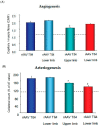Interdependence of Angiogenesis and Arteriogenesis in Development and Disease
- PMID: 35409246
- PMCID: PMC8999596
- DOI: 10.3390/ijms23073879
Interdependence of Angiogenesis and Arteriogenesis in Development and Disease
Abstract
The structure of arterial networks is optimized to allow efficient flow delivery to metabolically active tissues. Optimization of flow delivery is a continuous process involving synchronization of the structure and function of the microcirculation with the upstream arterial network. Risk factors for ischemic cardiovascular diseases, such as diabetes mellitus and hyperlipidemia, adversely affect endothelial function, induce capillary regression, and disrupt the micro- to macrocirculation cross-talk. We provide evidence showing that this loss of synchronization reduces arterial collateral network recruitment upon arterial stenosis, and the long-term clinical outcome of current revascularization strategies in these patient cohorts. We describe mechanisms and signals contributing to synchronized growth of micro- and macrocirculation in development and upon ischemic challenges in the adult organism and identify potential therapeutic targets. We conclude that a long-term successful revascularization strategy should aim at both removing obstructions in the proximal part of the arterial tree and restoring "bottom-up" vascular communication.
Keywords: AAV; MRTF-A; Trio; angiogenesis; arteriogenesis; blood flow; endothelial cell shape; sFlt1; shear stress.
Conflict of interest statement
C.K. is holding IP on AAV-MRTF-A for therapeutic neovascularization. F.l.N. declares no conflict of interest.
Figures





Similar articles
-
P2Y2 nucleotide receptor mediates arteriogenesis in a murine model of hind limb ischemia.J Vasc Surg. 2016 Jan;63(1):216-25. doi: 10.1016/j.jvs.2014.06.112. Epub 2014 Jul 31. J Vasc Surg. 2016. PMID: 25088742 Free PMC article.
-
Revascularization in the rabbit hindlimb: dissociation between capillary sprouting and arteriogenesis.Cardiovasc Res. 2001 Feb 16;49(3):618-25. doi: 10.1016/s0008-6363(00)00232-7. Cardiovasc Res. 2001. PMID: 11166275
-
Arteriogenesis: the development and growth of collateral arteries.Microcirculation. 2003 Jan;10(1):83-97. doi: 10.1038/sj.mn.7800173. Microcirculation. 2003. PMID: 12610665 Review.
-
Nanoparticle-mediated endothelial cell-selective delivery of pitavastatin induces functional collateral arteries (therapeutic arteriogenesis) in a rabbit model of chronic hind limb ischemia.J Vasc Surg. 2010 Aug;52(2):412-20. doi: 10.1016/j.jvs.2010.03.020. Epub 2010 Jun 22. J Vasc Surg. 2010. PMID: 20573471
-
Pharmaceutical interventions to influence arteriogenesis: new concepts to treat ischemic heart disease.Curr Med Chem. 2006;13(9):979-87. doi: 10.2174/092986706776360996. Curr Med Chem. 2006. PMID: 16611079 Review.
Cited by
-
The Intriguing World of Vascular Remodeling, Angiogenesis, and Arteriogenesis.Int J Mol Sci. 2024 Jun 9;25(12):6376. doi: 10.3390/ijms25126376. Int J Mol Sci. 2024. PMID: 38928082 Free PMC article.
-
Large differences in collateral blood vessel abundance among individuals arise from multiple genetic variants.J Cereb Blood Flow Metab. 2023 Nov;43(11):1983-2004. doi: 10.1177/0271678X231194956. Epub 2023 Aug 12. J Cereb Blood Flow Metab. 2023. PMID: 37572089 Free PMC article.
-
Aidi injection inhibits the migration and invasion of gefitinib-resistant lung adenocarcinoma cells by regulating the PLAT/FAK/AKT pathway.Chin Med. 2025 Jan 3;20(1):2. doi: 10.1186/s13020-024-01054-1. Chin Med. 2025. PMID: 39754146 Free PMC article.
-
Integrated Strategies for Targeting Arteriogenesis and Angiogenesis After Stroke.Transl Stroke Res. 2025 Aug;16(4):1383-1399. doi: 10.1007/s12975-024-01291-4. Epub 2024 Sep 3. Transl Stroke Res. 2025. PMID: 39225878 Review.
-
Tenascin-C in Tissue Repair after Myocardial Infarction in Humans.Int J Mol Sci. 2023 Jun 15;24(12):10184. doi: 10.3390/ijms241210184. Int J Mol Sci. 2023. PMID: 37373332 Free PMC article.
References
-
- Klems A., van Rijssel J., Ramms A.S., Wild R., Hammer J., Merkel M., Derenbach L., Préau L., Hinkel R., Suarez-Martinez I., et al. The GEF Trio controls endothelial cell size and arterial remodeling downstream of Vegf signaling in both zebrafish and cell models. Nat. Commun. 2020;11:5319. doi: 10.1038/s41467-020-19008-0. - DOI - PMC - PubMed
Publication types
MeSH terms
Grants and funding
LinkOut - more resources
Full Text Sources

